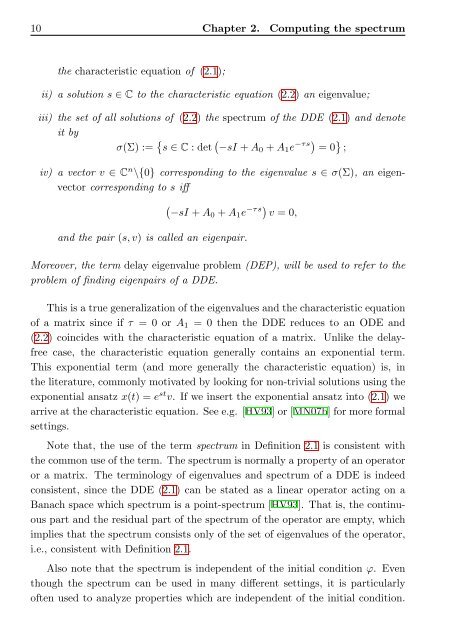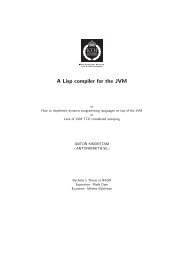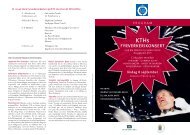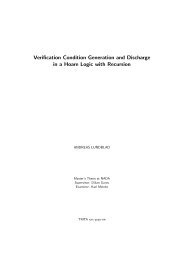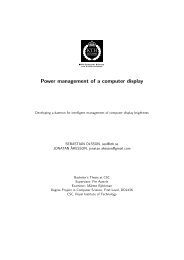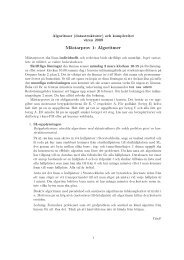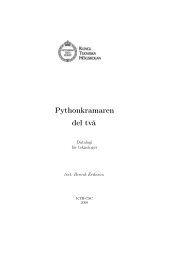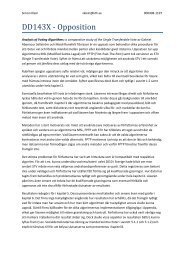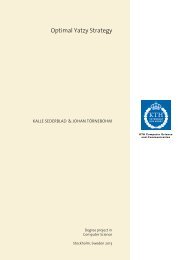The spectrum of delay-differential equations: numerical methods - KTH
The spectrum of delay-differential equations: numerical methods - KTH
The spectrum of delay-differential equations: numerical methods - KTH
You also want an ePaper? Increase the reach of your titles
YUMPU automatically turns print PDFs into web optimized ePapers that Google loves.
10 Chapter 2. Computing the <strong>spectrum</strong><br />
the characteristic equation <strong>of</strong> (2.1);<br />
ii) a solution s ∈ C to the characteristic equation (2.2) an eigenvalue;<br />
iii) the set <strong>of</strong> all solutions <strong>of</strong> (2.2) the <strong>spectrum</strong> <strong>of</strong> the DDE (2.1) and denote<br />
it by<br />
σ(Σ) := � s ∈ C : det � −sI + A0 + A1e −τs� = 0 � ;<br />
iv) a vector v ∈ C n \{0} corresponding to the eigenvalue s ∈ σ(Σ), an eigenvector<br />
corresponding to s iff<br />
� −sI + A0 + A1e −τs� v = 0,<br />
and the pair (s, v) is called an eigenpair.<br />
Moreover, the term <strong>delay</strong> eigenvalue problem (DEP), will be used to refer to the<br />
problem <strong>of</strong> finding eigenpairs <strong>of</strong> a DDE.<br />
This is a true generalization <strong>of</strong> the eigenvalues and the characteristic equation<br />
<strong>of</strong> a matrix since if τ = 0 or A1 = 0 then the DDE reduces to an ODE and<br />
(2.2) coincides with the characteristic equation <strong>of</strong> a matrix. Unlike the <strong>delay</strong>free<br />
case, the characteristic equation generally contains an exponential term.<br />
This exponential term (and more generally the characteristic equation) is, in<br />
the literature, commonly motivated by looking for non-trivial solutions using the<br />
exponential ansatz x(t) = e st v. If we insert the exponential ansatz into (2.1) we<br />
arrive at the characteristic equation. See e.g. [HV93] or [MN07b] for more formal<br />
settings.<br />
Note that, the use <strong>of</strong> the term <strong>spectrum</strong> in Definition 2.1 is consistent with<br />
the common use <strong>of</strong> the term. <strong>The</strong> <strong>spectrum</strong> is normally a property <strong>of</strong> an operator<br />
or a matrix. <strong>The</strong> terminology <strong>of</strong> eigenvalues and <strong>spectrum</strong> <strong>of</strong> a DDE is indeed<br />
consistent, since the DDE (2.1) can be stated as a linear operator acting on a<br />
Banach space which <strong>spectrum</strong> is a point-<strong>spectrum</strong> [HV93]. That is, the continuous<br />
part and the residual part <strong>of</strong> the <strong>spectrum</strong> <strong>of</strong> the operator are empty, which<br />
implies that the <strong>spectrum</strong> consists only <strong>of</strong> the set <strong>of</strong> eigenvalues <strong>of</strong> the operator,<br />
i.e., consistent with Definition 2.1.<br />
Also note that the <strong>spectrum</strong> is independent <strong>of</strong> the initial condition ϕ. Even<br />
though the <strong>spectrum</strong> can be used in many different settings, it is particularly<br />
<strong>of</strong>ten used to analyze properties which are independent <strong>of</strong> the initial condition.


